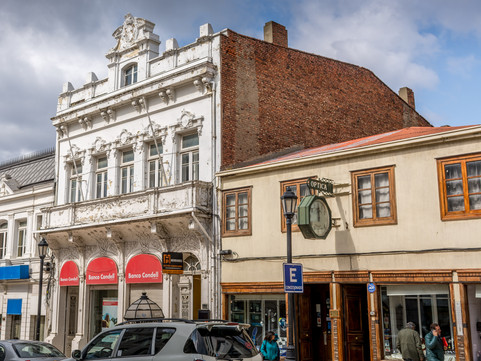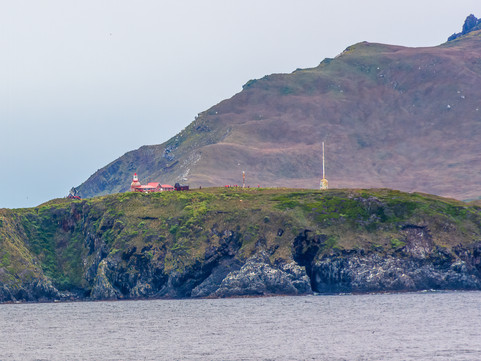
On the last days of January and first day of February 2020 we reached the mid-point of our Viking South America Cruise. At that point we left the Pacific Ocean, made stops in Punta Arenas Chile and Ushuaia Argentine before sailing into the South Atlantic Ocean.
Located at the southernmost tip of South America, Tierra del Fuego is an archipelago made up of mountainous, snow and glacier covered islands. Beyond the archipelago is the vast ocean area between Antarctica and South America connecting the Atlantic and Pacific Oceans. This is the treacherous Drakes Passage.
The Strait of Magellan is the channel that runs from the Atlantic to the Pacific and separates the mainland from the archipelago. The first European to discover this waterway and surrounding areas was the famous Portuguese explorer Ferdinand Magellan. Magellan observed many bon fires throughout the landscape set by the indigenous peoples, so he named the area Tierra del Fuego, “Land of Fire”.
Further south in the archipelago is another passage between the Atlantic and Pacific, the Beagle Channel. We would transit the Beagle Channel toward the end of our time here to visit the worlds southernmost city, Ushuaia Argentina, before crossing into the South Atlantic, followed by a cruise around Cape Horn.
The following are some of the highlights of our visit to the very southernmost points of the Western Hemisphere.
Strait of Magellan and Punta Arenas
Early in the morning of January 30, 2020 the Viking Jupiter left the Pacific Ocean and entered the Strait of Magellan, our destination that morning was Punta Arenas Chile where we would dock and spend the day on shore excursions. Punta Arenas, our last stop in Chile, is located on the north side of the Strait of Magellan and is the last city on mainland South America.
We spent the day in Punta Arenas, where we opted for the included 3-hour walking tour of the town. The ship was alongside the main pier which is in the center of town and our walking tour started right from the dock where we met our local tour guide, a young man who was deeply knowledgeable, an excellent guide! This is one of the things we like about Viking, they always use excellent local tour guides.
Our tour started along the waterfront where we visited a park with a large maritime monument. This monument called “Monumento A Tripulantes Goleta Ancud”, commemorating the crew of the schooner Ancud, sent by the government of Chile in 1843 to establish sovereignty over the Strait of Magellan. The park also had a monument commemorating the 500-year anniversary (1520-2020) of the discovery of the Strait of Magellan.
From the waterfront we could see many large rusting fishing boats anchored in the strait. Our guide told us these are Chinese fishing boats. He said the locals call them “prison ships”, because they come in and stay for weeks or even months, no one is seen leaving. He told us the Chilean Navy keeps an eye on them and there have been occasions where unidentified bodies have been retrieved from the waters and it is assumed, they are deceased Chinese fishermen. There are widespread reports in the international press about forced labor and horrific working conditions on these vessels.
As we walked through the town it was a bit disheartening to see the damage, graffiti and vandalism to buildings and monuments from the recent 2019 riots and unrest. The highlight of the tour was the walk up to a hilltop vista point, Cerro de la Cruz, (steep sidewalks and lots of steps) which offered a great view of the town with the Strait of Magellan in the background. We also walked through the town’s small central plaza called Plaza Armas Punta Arenas with its monument to Magellan. The monument depicts Magellan along with local indigenous native nicked named “Big Foot”. Local tradition is to rub or kiss the foot of the native, will assure a return to Punta Arenas.
By mid-afternoon it was time to return to the ship. The wind was strong and the walk along the pier to the ship was quite challenging. When the ship left the dock, the wind was so strong, two powerful tugboats were needed to pull the ship way from the pier. We were then off, heading back west and then south to Beagle Channel and our next port, Ushuaia Argentina.
Sailing the Strait of Magellan into the Port of Punta Arenas
Walking Tour of Punta Arenas
Waterfront and Monumento A Tripulantes Goleta Ancud
Architecture and Homes of Punta Arenas
Views from Cerro de la Cruz
Plaza Armas Punta Arenas
Chinese Fishing Boats
Tugs Assisting Viking Jupiter
Ushuaia Argentina
Just after sunrise on 31 January 2020, the Viking Jupiter sailed into the Beagle Channel, with its stunning landscape of rugged snow-covered mountainous islands on both sides of the channel. We would eventually meet the Pilot Boat where the Harbor Pilot came onboard to guide the ship through the harbor and onto our mooring spot on a long, busy pier. The Viking Jupiter would tie up at the big commercial pier in Ushuaia by mid-morning.
There were quite a few ships alongside the pier, most of the ships were Antarctic expedition ships. Ushuaia is the main logistics base for Antarctica, it is the closest major port facility to the frozen continent, about 600 nautical miles (1,100km) to the closest point, on the Antarctic Peninsula.
Upon arrival, we joined a brief bus tour of Ushuaia, then we had the afternoon free to explore the town. Ushuaia, the world’s southernmost city, also known as the “End of the World”, is the capitol of the Tierra del Fuego Province of Argentina. It is a small, but remarkably interesting city, sporting a Hard Rock Café (the worlds southernmost Hard Rock), and surprisingly, one of South America’s best chocolate shops, Laguna Negra. We didn’t go into the Hard Rock, but we did go to the chocolate shop sampled several varieties and we bought a large selection of yummy treats to enjoy on the cruise (they didn’t last long).
We had lunch at a very pleasant restaurant called Andino Gourmet. We would spend the rest of the afternoon walking around the town, checking out the interesting architecture, street murals and eclectic shops.
Early Morning Sailing in Beagle Channel
Ushuaia Waterfront
Walking Around Ushuaia
Laguna Negra Chocolate Shop
Rounding Cape Horn
The ship would depart Ushuaia late afternoon and sail east toward the South Atlantic Ocean. Early the next morning, February 1, 2020, the ship approached Isla Hornos or Horn Island where we would pass by its famous Cape Horn. Horn Island is the southernmost island of the archipelago and Cape Horn is the southernmost tip of the Americas. Part of this Viking Cruise itinerary was to “round Cape Horn”, where the ship would approach Cape Horn slowly so that we could get pictures and view the famous lighthouse. It was a cloudy but clear day, so we got a good view of the lighthouse and nearby Cape Horn Monument, a sculpture that pays homage to sailors that perished attempting to round Cape Horn.
There were several smaller expedition type cruise ships anchored close to the island and they were shuttling their passengers by zodiac boats to the island for hiking tours. Our ship did a complete circle around Horn Island before proceeding east into the South Atlantic and our next stop, the Falklands.
There are several nautical traditions associated with rounding Cape Horn. Sailors would wear a looped gold earring in the ear facing the Cape (left ear for east passage, right ear for west passage), or sailors would smoke cigars and pour alcohol into the sea to honor those who were lost. We didn’t adhere strictly to those traditions, but a libation may have offered in the Explorers’ Lounge that evening.
Sunrise on Drake Passage
Rounding Cape Horn


































































































































Comments